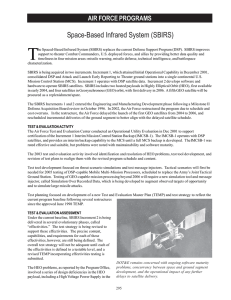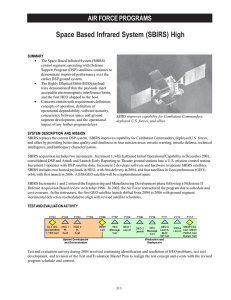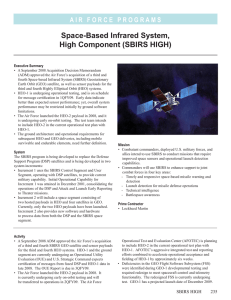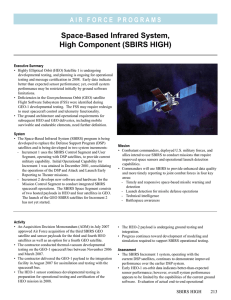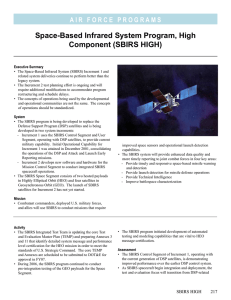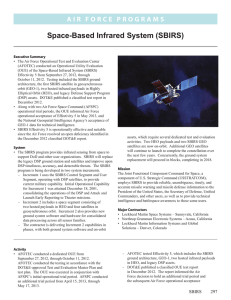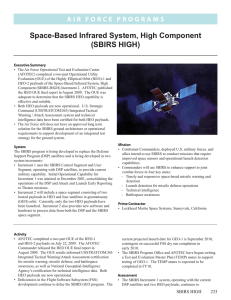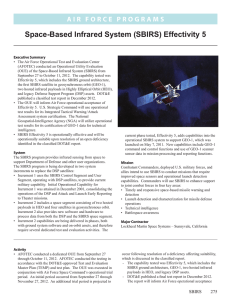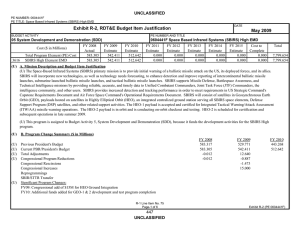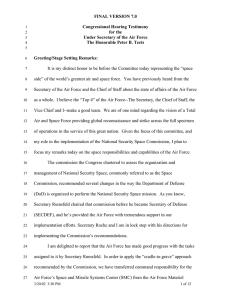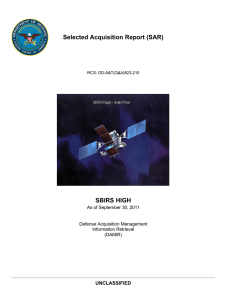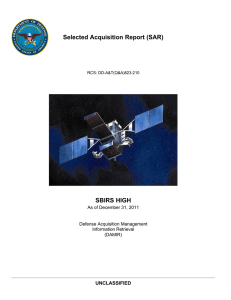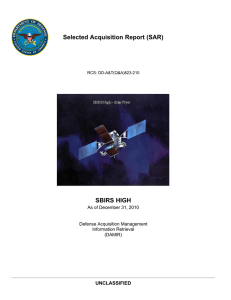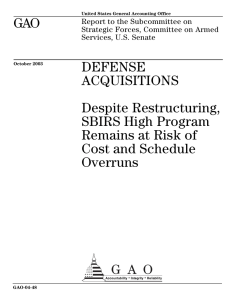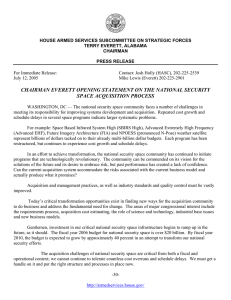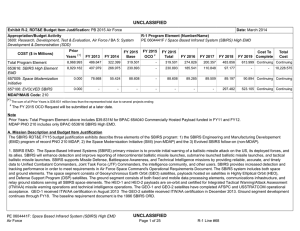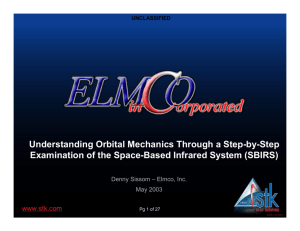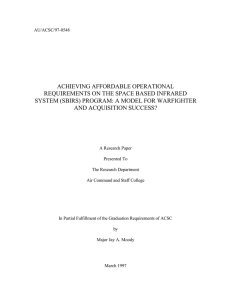Space-Based Infrared System, High Component (SBIRS HIGH)
advertisement
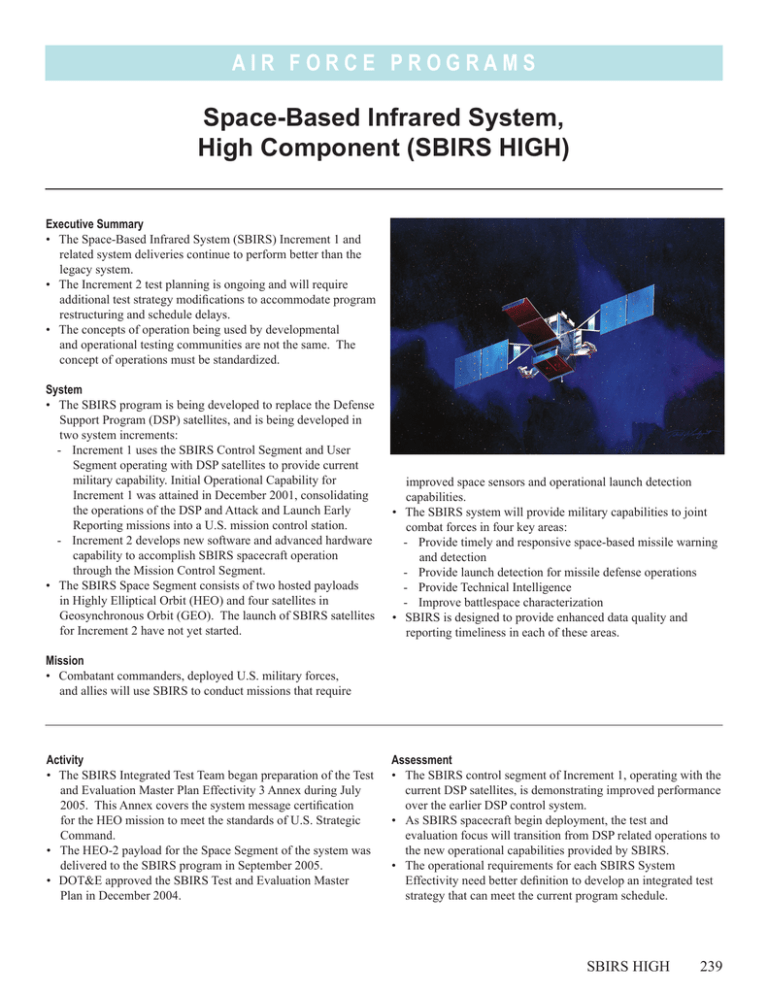
AIR FORCE PROGRAMS Space-Based Infrared System, High Component (SBIRS HIGH) Executive Summary • The Space-Based Infrared System (SBIRS) Increment 1 and related system deliveries continue to perform better than the legacy system. • The Increment 2 test planning is ongoing and will require additional test strategy modifications to accommodate program restructuring and schedule delays. • The concepts of operation being used by developmental and operational testing communities are not the same. The concept of operations must be standardized. System • The SBIRS program is being developed to replace the Defense Support Program (DSP) satellites, and is being developed in two system increments: - Increment 1 uses the SBIRS Control Segment and User Segment operating with DSP satellites to provide current military capability. Initial Operational Capability for Increment 1 was attained in December 2001, consolidating the operations of the DSP and Attack and Launch Early Reporting missions into a U.S. mission control station. - Increment 2 develops new software and advanced hardware capability to accomplish SBIRS spacecraft operation through the Mission Control Segment. • The SBIRS Space Segment consists of two hosted payloads in Highly Elliptical Orbit (HEO) and four satellites in Geosynchronous Orbit (GEO). The launch of SBIRS satellites for Increment 2 have not yet started. improved space sensors and operational launch detection capabilities. • The SBIRS system will provide military capabilities to joint combat forces in four key areas: - Provide timely and responsive space-based missile warning and detection - Provide launch detection for missile defense operations - Provide Technical Intelligence - Improve battlespace characterization • SBIRS is designed to provide enhanced data quality and reporting timeliness in each of these areas. Mission • Combatant commanders, deployed U.S. military forces, and allies will use SBIRS to conduct missions that require Activity • The SBIRS Integrated Test Team began preparation of the Test and Evaluation Master Plan Effectivity 3 Annex during July 2005. This Annex covers the system message certification for the HEO mission to meet the standards of U.S. Strategic Command. • The HEO-2 payload for the Space Segment of the system was delivered to the SBIRS program in September 2005. • DOT&E approved the SBIRS Test and Evaluation Master Plan in December 2004. Assessment • The SBIRS control segment of Increment 1, operating with the current DSP satellites, is demonstrating improved performance over the earlier DSP control system. • As SBIRS spacecraft begin deployment, the test and evaluation focus will transition from DSP related operations to the new operational capabilities provided by SBIRS. • The operational requirements for each SBIRS System Effectivity need better definition to develop an integrated test strategy that can meet the current program schedule. SBIRS HIGH 239 AIR FORCE PROGRAMS • Lack of accredited models and the delayed development of SBIRS test scenarios and simulations, increases the program risk for exceeding the program timelines associated with scheduled test events. • There are emerging differences between the concepts of operation being used during the developmental and operational phases of testing. This reduces synchronization in the structure of the overall test program. Recommendations 1. The Air Force should adequately specify the operational requirements for each SBIRS Effectivity to achieve the timely development of the corresponding Test and Evaluation Master Plan Annexes. 240 SBIRS HIGH 2. The Air Force should resolve delays associated with developing accredited system models for critical SBIRS testing, and identify timely delivery dates to meet the needs of the operational test schedule. 3. The Air Force should resolve the differences in the concept of operations being employed for the different phases of SBIRS testing in order to meet the integrated needs of the test program. 4. The Air Force should conduct integrated operational testing of SBIRS HEO message certification for the System Effectivity 3/11 to meet the needs of certification and operational acceptance by U.S. Strategic Command.
